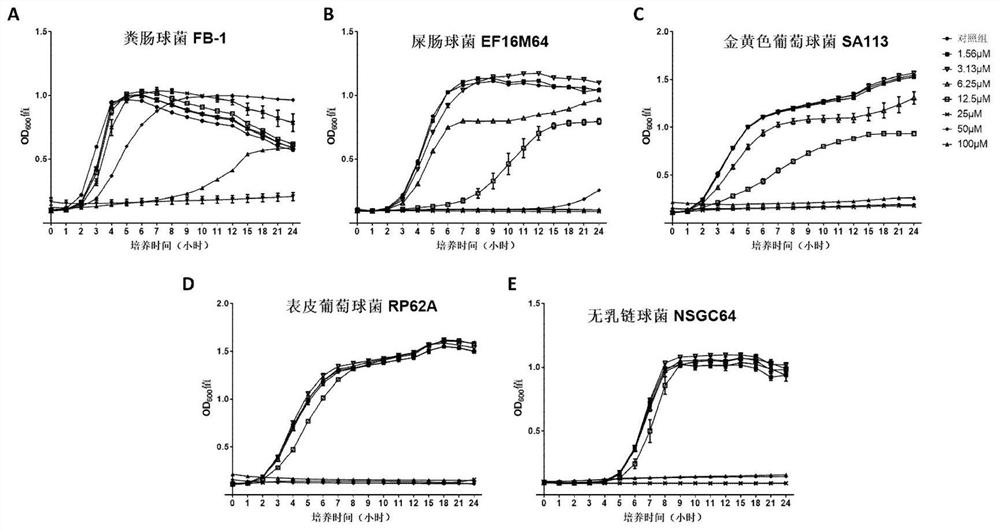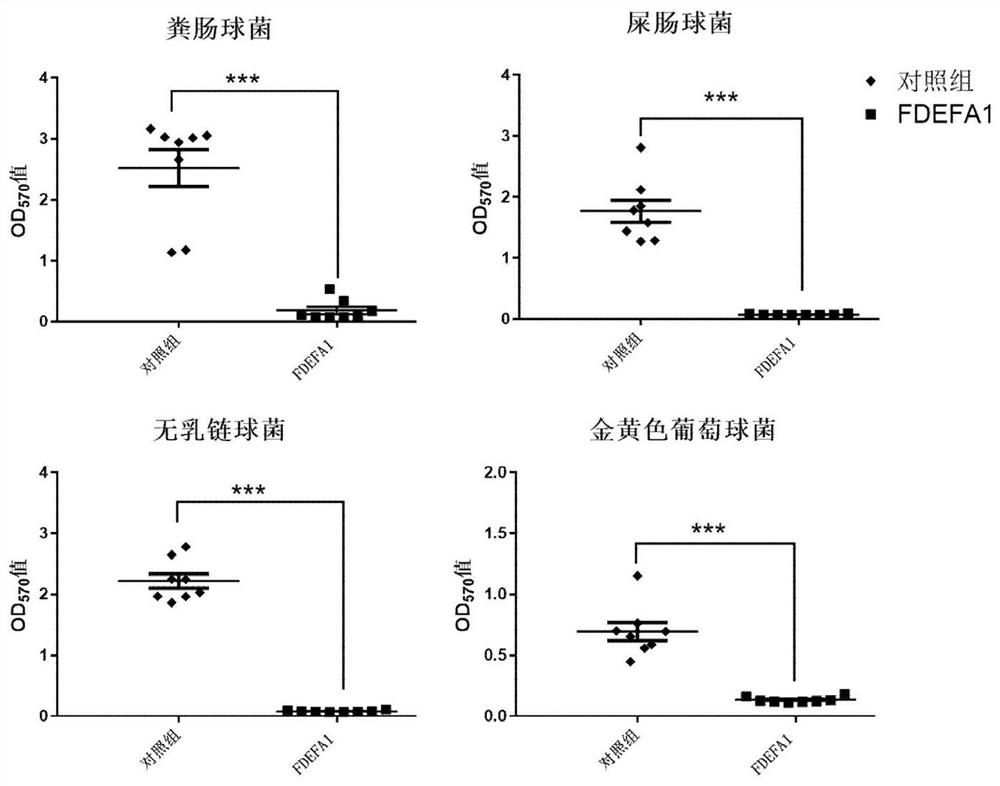Application of compound FDEFA1 in preparation of gram-positive coccus inhibitor
A gram-positive, gram-positive technology is applied in the field of compound FDEFA1 in the preparation of gram-positive coccus inhibitors
- Summary
- Abstract
- Description
- Claims
- Application Information
AI Technical Summary
Problems solved by technology
Method used
Image
Examples
Embodiment 1
[0023] Example 1 Compound FDEFA1 inhibits the activity of Enterococcus faecalis histidine kinase YycG
[0024] Obtain the Enterococcus faecalis histidine kinase YycG gene sequence (NC_017316) through the Pubmed database: design an NcoI restriction site at the 5' end of the sense strand primer, and design an XhoI restriction site at the 5' end of the antisense strand primer: sense: 5' -CATG CCATG G TCGAAAGACGGGAATTTGTTTCCAAT-3', the underlined part is NcoⅠ restriction site; antisense: 5'-CCG CTCG AG AGGTTCATATGGTAGTGAAATATAG-3', the underlined part is the XhoI restriction site; the target fragment of Enterococcus faecalis histidine kinase YycG was amplified by PCR with the above primers, and the restriction endonuclease (NcoI and XhoI) digestion reaction and T 4 DNA ligase ligation reaction, the above target fragments were connected with the pET28(a) vector, transformed into DH5α bacteria, positive colonies were selected, and sequencing confirmed the successful construct...
Embodiment 2
[0029] Embodiment 2 Compound FDEFA1 inhibits the growth of Gram-positive planktonic bacteria
[0030] Bacterial strains used in the antibacterial test: Enterococcus faecalis FB-1, Enterococcus faecium EF16M64, Staphylococcus aureus SA113, Staphylococcus epidermidis RP62A and Streptococcus agalactiae NSGC64.
[0031]The strain was cultured overnight, inoculated into 4 mL of fresh TSB medium at 1:200, and compound FDEFA1 was serially diluted with TSB medium (from 200 μM to 3.13 μM), and after dilution, 150 μL was added to the matching detection orifice plate of the Bioscreen instrument; Then add 150 μL of the above-mentioned bacterial solution to three replicate wells, and use the bacterial solution without compound as the positive control; set the parameters and read the OD every half an hour 600 Value, continuous monitoring for 24h, the obtained value draws the growth curve, and the experiment is repeated three times;
[0032] The results showed that the compound FDEFA1 could...
Embodiment 3
[0033] Antibacterial activity test of embodiment 3 compound FDEFA1 to 477 enterococci and streptococcus agalactiae clinical strains
[0034] This embodiment uses the micro broth dilution method recommended by the U.S. Clinical and Laboratory Standards Institute (CLSI) to detect the effect of compound FDEFA1 on 477 clinical strains (including 257 strains of Enterococcus faecalis; 102 strains of Enterococcus faecium; 118 strains of Streptococcus agalactiae). MIC value.
[0035] Resuscitate the bacteria, inoculate them in 5 mL of fresh TSB liquid medium, and cultivate overnight at 37°C with shaking at 220rpm; dilute the above-mentioned bacterial liquid with TSB medium to OD=0.1, place on a shaker at 37°C and shake and culture until logarithmic growth phase, Take 1 mL of the bacterial solution in the growth period and centrifuge it in a 1.5 mL EP tube, and dilute the bacterial cells with sterile saline to adjust the turbidity to 0.5 McFarland turbidity (that is, equivalent to 1.0×...
PUM
 Login to View More
Login to View More Abstract
Description
Claims
Application Information
 Login to View More
Login to View More - R&D
- Intellectual Property
- Life Sciences
- Materials
- Tech Scout
- Unparalleled Data Quality
- Higher Quality Content
- 60% Fewer Hallucinations
Browse by: Latest US Patents, China's latest patents, Technical Efficacy Thesaurus, Application Domain, Technology Topic, Popular Technical Reports.
© 2025 PatSnap. All rights reserved.Legal|Privacy policy|Modern Slavery Act Transparency Statement|Sitemap|About US| Contact US: help@patsnap.com



